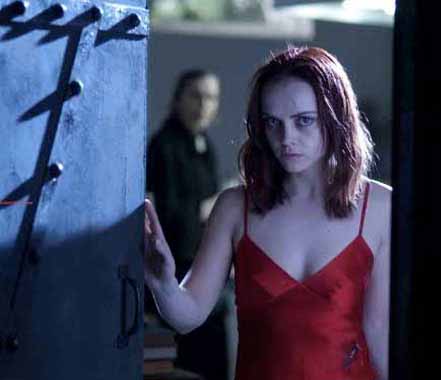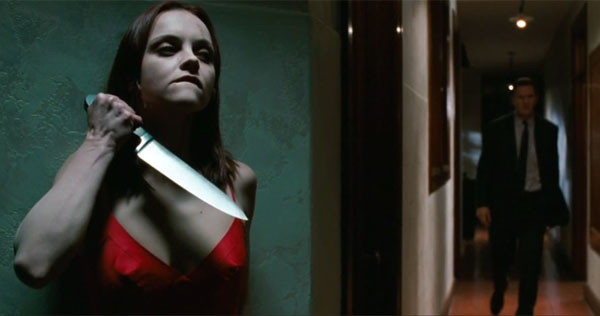 Built around an intriguing premise, this ambitious little horror movie deserves credit for its art house aspirations, focusing on characterization, ideas, and intrigue instead of violence and shock; unfortunately, this is a case when “vaulting ambition” o’erleaps itself and falls victim to its own seriousitude, the heavy-handed approach collapsing under its own weight and generating laughter instead of pathos. A generous viewer could cut the film some slack in this regard, had the film stayed true to its intentions; unfortunately, AFTER.LIFE eventually wimps out on its own premise, shifting from a thoughtful meditation on themes of life and death into a manipulative thriller, with some extremely unlikely (well, frankly impossible) twists and turns. Curious fans of Christina Ricci, Liam Neeson, and/or Justin Long may want to risk a viewing, even if the film ultimately fails to live up to their best efforts.
Built around an intriguing premise, this ambitious little horror movie deserves credit for its art house aspirations, focusing on characterization, ideas, and intrigue instead of violence and shock; unfortunately, this is a case when “vaulting ambition” o’erleaps itself and falls victim to its own seriousitude, the heavy-handed approach collapsing under its own weight and generating laughter instead of pathos. A generous viewer could cut the film some slack in this regard, had the film stayed true to its intentions; unfortunately, AFTER.LIFE eventually wimps out on its own premise, shifting from a thoughtful meditation on themes of life and death into a manipulative thriller, with some extremely unlikely (well, frankly impossible) twists and turns. Curious fans of Christina Ricci, Liam Neeson, and/or Justin Long may want to risk a viewing, even if the film ultimately fails to live up to their best efforts.
Anna Tayler (Ricci) is a school teacher whose relationship with Paul (Long) is deteriorating for unclear reasons, apparently some vague angst on her part. After an argument at a restaurant, Anna gets in a car accident and wakes up to find herself being prepped for burial by funeral director Eliot Deacon (Liam Neeson), whose reaction is curiously calm as he insists that Anna is dead despite being conscious. Reluctant to take Deacon at his word, Anna tries to escape and contact Paul, who mistakes her telephone call for a sick prank but grows suspicious when one of Anna student’s claims to have seen her standing in a window of the mortuary.
The storyline of AFTER.LIFE follows two tracks. The first presents a vision of how the dead might look back upon their life and loved ones after being unshackled from the earthly cares that weighed them down while alive. Essentially, this is a horror-movie spin on the final act of Thorton Wilder’s play Our Town. Not a bad idea at all, it offers the film a chance to ruminate on themes of life and death with a morbid fascination that at first seems poised on the brink of achieving its higher ambitions.

Unfortunately, these ambitions are undermined by the story’s second track, which is more conventional – although, at least initially, handled with some intriguing flair. The question fueling this aspect of the plot is whether Anna is really in limbo, with Deacon acting as a sort of Angel of Death easing her to the other side, or is she really still alive – merely the victim of some bizarre mind game played by Deacon for mysterious reasons of his own? Director Agnieszka Wojtowicz-Vosloo offers a series of clues that tease the audience with their implications (for example, several hallucinatory scenes offer visual echoes of each other, suggesting that the film may be a post-mortem dream in Anna’s head), but eventually it becomes obvious that she and her co-writers Paul Vosloo and Jakub Korolczuk have not thought their story through.
[SPOILERS AHEAD]
After three days on the slab, having finally been convinced by Deacon that she is dead, Anna realizes that she is actually still alive when she sees her warm breath fog a mirror. The fact that she hasn’t eaten a meal during this time – and should be ravenously hungry – does not seem to have occurred to the writers, nor are they concerned with the unpleasant aspect of bodily functions (e.g, relieving bladder and bowels), which should have clued Anna in to the fact that her life process were still fully functional.
By abandoning its core conceit, AFTER.LIFE abandons its its hold on our attention, along with the art house ambitions that would have justified its serous tone and relatively restrained approach to the horror genre. What remains is too mild to work as a gripping thriller and too contrived to evoke audience empathy. Instead of an ambiguous, almost abstract psycho-drama (a la the wonderful 1989 film CLOSET LAND, with Alan Rickman and Madeline Stowe), we get sub-prime Lucio Fulci, without the gore or the suspense; and even AFTER.LIFE’s absurdity lacks the charm of Fulci’s (supposedly) intentional disregard for narrative logic.
[END SPOILERS]
On the plus side, there are some clever touches. Just before her car accidental, Anna dyed her hair red (red being the color of blood, which can symbolize passion and life). In the mortuary, Anna’s grieving mother instructs Deacon to restore Anna’s original hair color. When the red dye rinses down the drain, it resembles lifeblood washing away, Anna’s attempt to embue herself with artificial, symbolic life stripped away as she is infantalized, her appearance no longer dicatated by herself but now by her mother.
Neeson and Long deliver good performances, even if the script prevents them from crafting fully realized characters. In the case of Neeson’s mortician, the problem is that the mystery surrounding the character prevents any depth from developing, and as good as he is, Neeson is not the sort who can fill in the blanks with his mere presence. Long’s problem is simply that his character is ineffectual and at times bathetic (at one point, the film indicates his grief-stricken mental state by having him strike a child – a scene that generates derisive guffaws).

Even more on the plus side (at least for the male audience), Ricci looks great in the red satin slip she wears throughout most of the film (again, the red suggesting the fire buried deep within her soul, which is otherwise not apparent in her physical appearance, which is dark and subdued). She has the perfect Goth look to convey a character poised somewhere between life and death, which only makes AFTER.LIFE’s brief flirtation with presenting her as “La Morte Amoureuse” all the more frustrating when it is simply abandoned. Even when the script forces Ricci to completely undress for the final act, the visual approach remains impressively non-exploitative (perhaps because the director is a woman), with cool-blue lighting giving the impression that we are viewing something akin to living sculpture, whose form is truly breath-taking.
This may be one of the AFTER.LIFE’s more successful stabs at subtlety: making us view the character as a beautiful object, a soul-less body, just as Deacon is finally convincing Anna that she is truly lifeless, a walking, talking non-entity who merely imitates life out of robotic habit. Had the film fully explored this idea, it might actually have achieved its ambitions.
AFTER.LIFE (Copyright 2009; theatrical release: April 9, 2010). Directed by Agnieszka Wojtowicz-Vosloo. Written by Agnieszka Wojtowicz-Vosloo & Paul Vosloo & Jakub Korolczuk. Cast: Christina Ricci, Liam Neeson, Justin Long.
[serialposts]
